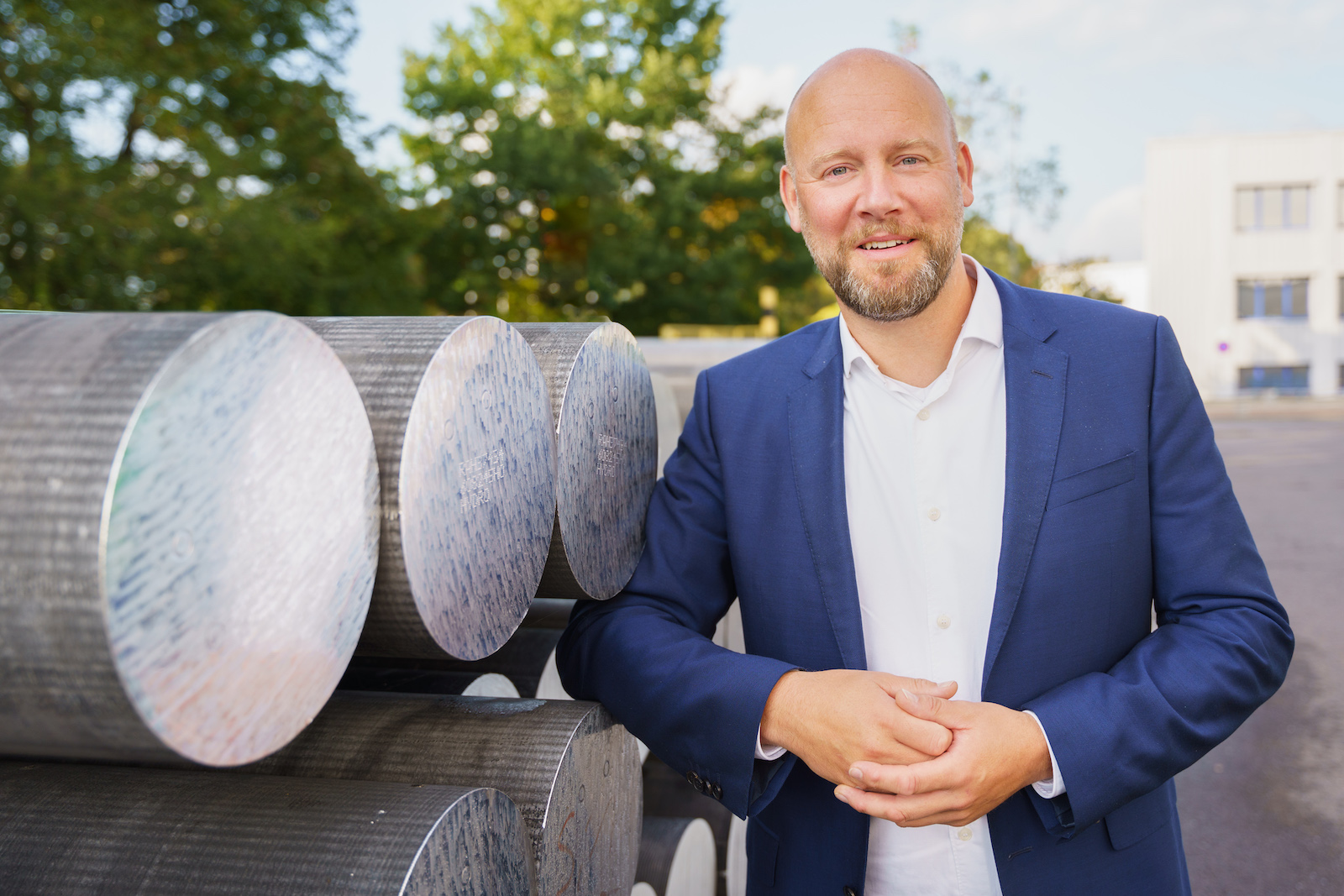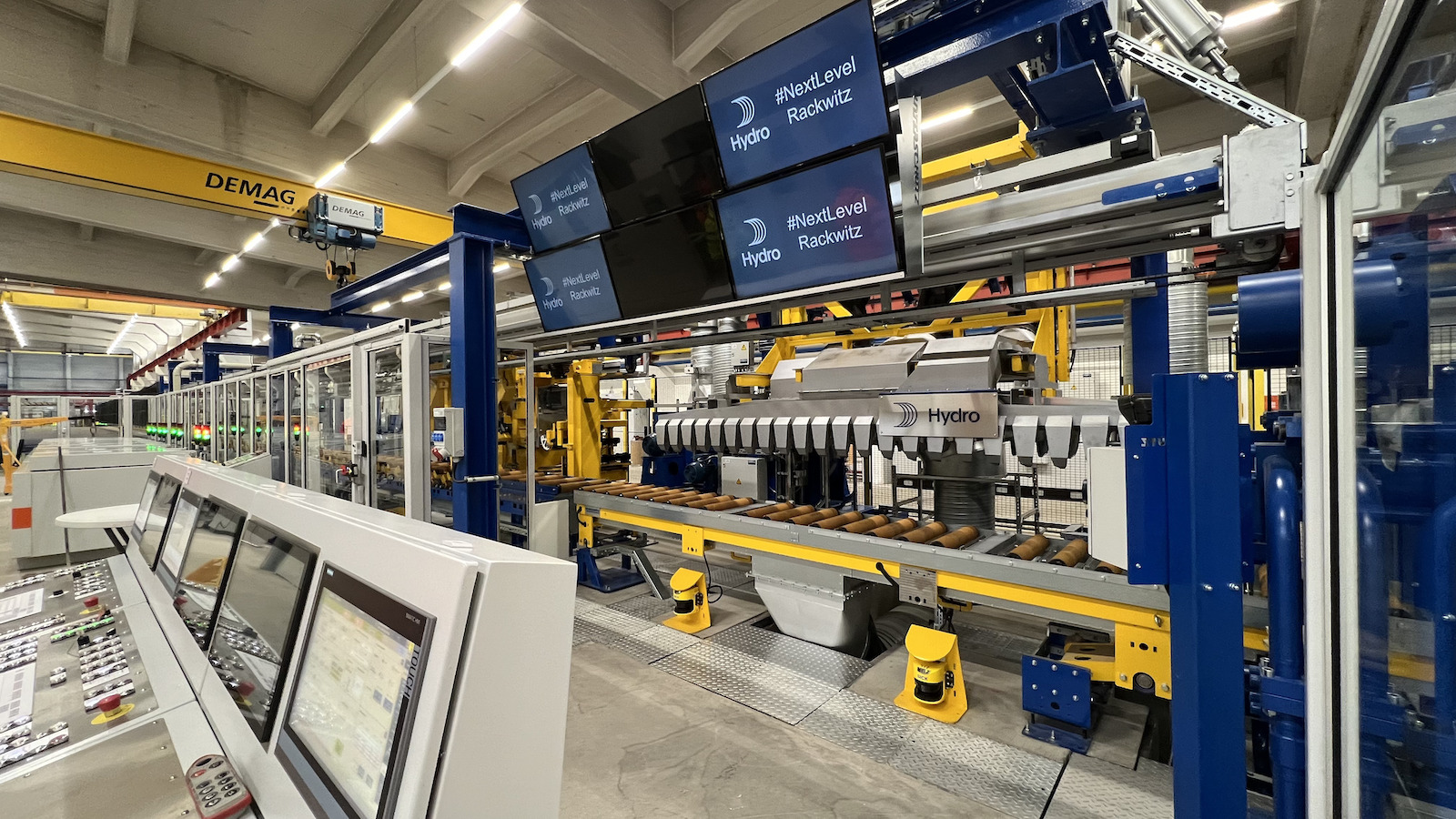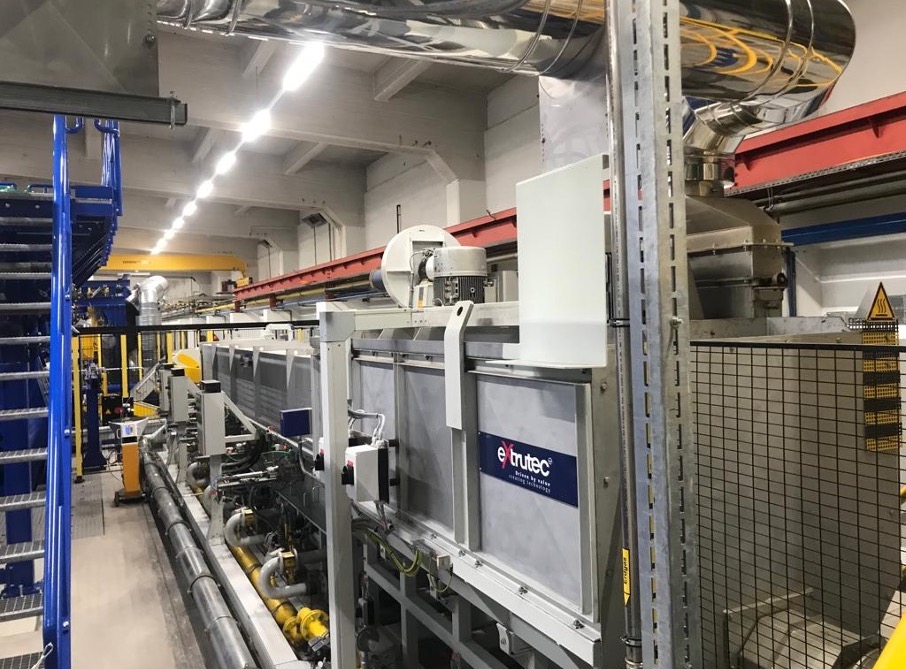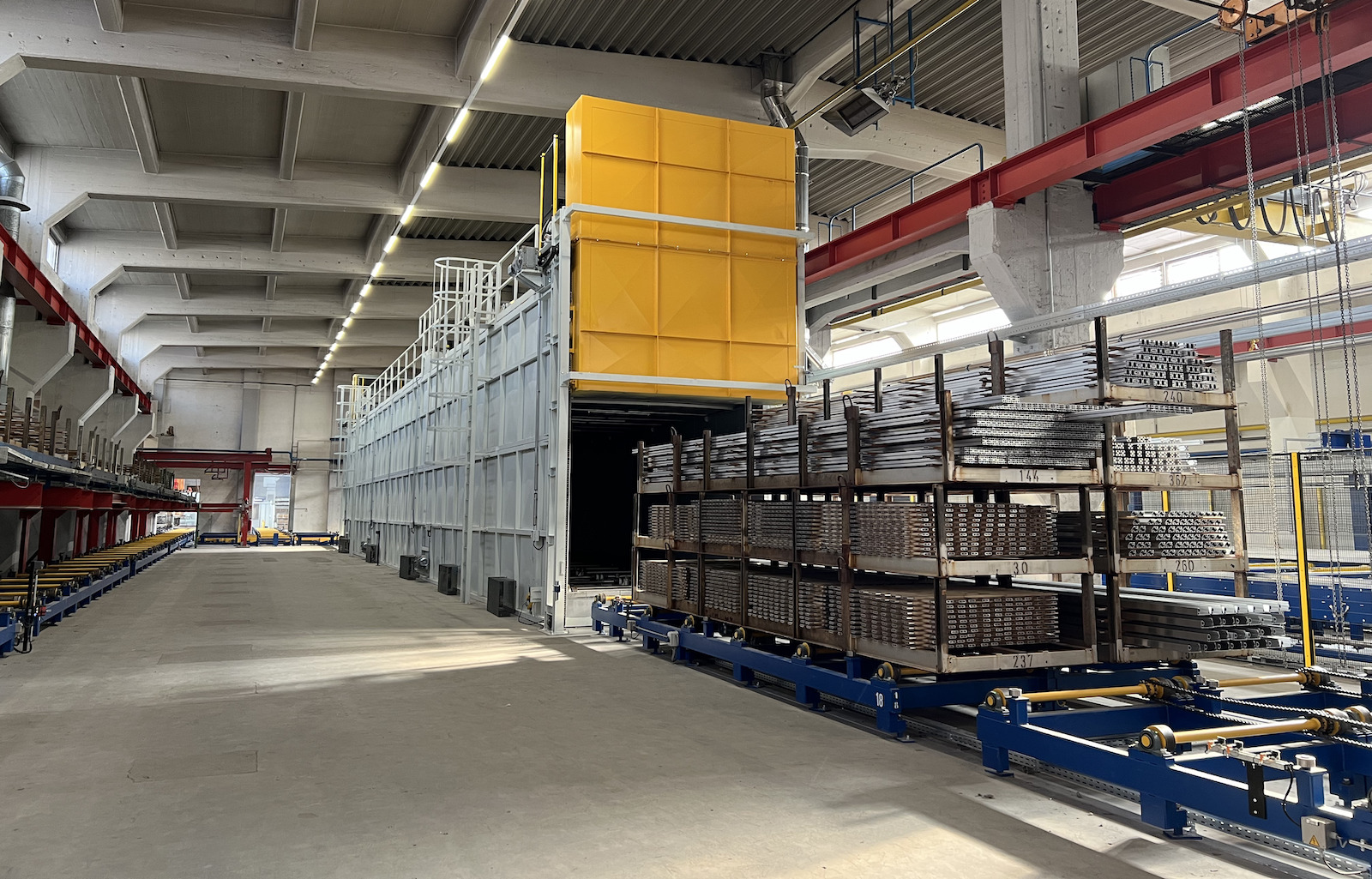Hydro Extrusions recently expanded its extrusion operation in Rackwitz, Germany, with the installation of a third extrusion press line, which was officially put into operation at the end of 2023. The €11 million project includes a 22 MN, 8 inch upcycled extrusion press, along with an energy efficient aging oven—representing a solid investment in the strong German market. The P22 extrusion press line increases the production capacity for high quality complex extruded profiles, enabling the Rackwitz facility to meet growing demand from the construction, transportation, and general mechanical engineering sectors. In addition, the state-of-the-art line improves the efficiency and sustainability of the facility, enabling the site to provide even better service to its customers.
Rackwitz Overview
Founded in 1925, the Rackwitz facility produces custom aluminum profiles, while also offering support for technical and economical product optimization. Hydro has been committed to expanding and upgrading the facility since it was launched. In addition to its extrusion capabilities, the plant features a fully automatic anodizing line and extensive fabrication capabilities.
The anodizing line was installed in 2010, enabling the site to be a one-stop solution for customers. “The anodizing line is one of the most modern lines in Europe,” said Matthias Hellmann (Figure 1), managing director of Hydro Extrusions Rackwitz. “We produce 2.5 million sq m of anodized profiles per year. Besides natural anodizing (C-0), we also offer color anodizing ranging from C31 to C35. We can also do piece anodizing in our plant.”

With the recently completed expansion project, the site now operates a total of three extrusion presses. This increases production by 30%, bringing it from its previous capacity of 27,000 tons of aluminum per year up to 40,000 tons per year. “At the moment, we have 250 employees and over 650 customers,” noted Hellmann. “The site also meets the highest safety and sustainability standards. It is Aluminium Stewardship Initiative and Environmental Product Declaration (EPD) certified, as well as being certified to EN 15088 and ISO 14001, 9001, 45001, and 50001.”
New Press Line
The expansion project at Rackwitz involved the installation of the upcycled extrusion press, new handling systems, and a new aging oven in an existing building, along with other logistical improvements at the site. “We were lucky that we already had space available in our production hall. The space had been previously used for a press in the 1990s. More recently, it was an area for finished goods, which was moved to a new external warehouse outside the hall,” explained Hellmann. “We have also centralized and expanded our ingot storage area and have increased our packing capacity with additional stations to ensure smooth processing of finished goods and to meet the increased volume requirements.”
Hydro purchased a second-hand press from a competitor in Germany, which was upcycled for the new line. “There are two main reasons we chose to upcycle the press,” said Hellmann. “First, upcycling a press goes hand in hand with Hydro’s sustainability goals. Why scrap it when you can give it a new life? Second, this was the quickest solution for implementing the concept as planned.”
Unterschütz Sondermaschinenbau GmbH, a German specialist in aluminum extrusion equipment, performed the upgrade on the press, as well as providing handling systems and equipment for the rest of the line. The company supplied mechanical engineering, project management, assembly, and commissioning support for this project.
The main focus of the upcycling work on the 22 MN, 8 inch press involved updating the hydraulics system, which was completely redesigned by Unterschütz. The company also replaced essential moving parts and installed a new energy efficient container and container housing, press rest, and bolster shear. Outdated, low-performance drives and frequency converters were updated with the latest generation systems. The entire electrical system and control were refreshed, and a modern HMI with extended safety features was integrated into the press system (Figure 2), including a separate handheld control unit. Additional safety features for personal protection include a safety flap at the counter plate, along with video recording during the press start and a main cylinder lockout system that is implemented during maintenance work.

Where possible, Unterschütz focused on reusing existing parts and components. For example, energy- and resource-intensive forged parts were reprocessed and reused (including the main cylinder holder, counter plate, and tie rods), resulting in a significant reduction of the carbon footprint during the upcycling process. The improved press is also more energy efficient and durable, enabling stable production of high-quality profiles in 6060 and 6005 alloys.
The complete press feed line was modernized by extrutec GmbH in Moos, Germany. As with the press, the existing gas furnace was upcycled in order to be as resource efficient as possible (Figure 3). In particular, the furnace was outfitted with extrutec’s patented Eco Shower Unit (ESU), an energy saving system that significantly reduces the carbon footprint of the furnace. It heats the billets from room temperature up to 90°C by using residual heat in the exhaust gas of the billet heater, which ensures a gas savings in the range of 15–17%, while simultaneously increasing the throughput of the furnace. Furthermore, an air-water heat exchanger system was implemented, which features a closed water circuit, automatic water level control, and a corrosion-resistant design. The heat exchanger system increases the efficiency of the billet furnace by 90%.

In addition, the press feed line was equipped with a new vertical log storage system and a hot log saw. Replacing the previously existing hot shear with a new hot log saw directly results in a significant scrap reduction, which helps to further improve the CO2 balance as well as reduce production costs. Overall, the revamped press feed line not only improves the overall process control by homogeneously heating the billets, but also boosts the productivity of the press line.
The handling system supplied by Unterschütz includes a double puller system with a flying hot saw, which is guided from above using a patented pulling force regulation system that prevents compressing or elongation of profiles. The state-of-the-art runout table features an advanced cooling bed, with powerful frequency-regulated radial fans that help to reduce water and energy consumption. The runout table also includes integrated sample handling, which enables operators to easily monitor the quality of the profiles.
The handling system includes an 80 ton stretcher, a finishing saw, and an automatic stacker with spacer handling, as well as a long scrap management system. Significant attention was given to noise reduction throughout the work environment. For example, glass barriers were installed instead of a wire fence, and the finishing saw was completely enclosed to minimize noise. Communication between the various handling systems is achieved using Profinet and managed through a modern control center that not only ensures efficient production, but also monitors and manages all safety-critical processes.
A new continuous aging oven (Figure 4) was supplied by Cometal Engineering S.p.A., headquartered in Brescia, Italy. The aging oven is comprised of a two-chamber system, including a preheating chamber (able to receive one batch of eight baskets) and a soaking chamber (able to hold two full batches with eight baskets each). Both chambers are outfitted with special burners and a single fan that is controlled by a frequency converter. The preheating chamber quickly heats the batch to the required temperature, while the soaking chamber is dedicated to maintaining a stable temperature throughout the entire heat treatment process.

The oven is outfitted with three independent, vertically opened doors, with the internal door helping to avoid heat loss in the soaking chamber. This also helps to ensure that the soaking chamber remains at a constant temperature requiring minimal heating power, resulting in extremely low gas consumption. Thanks to the temperature stability of the continuous aging oven, the thermal treatment of the profile is very homogenous and precise with an optimal temperature accuracy. The oven is also able to maximize throughput, with automatically programmed controls that allow it to operate even during off shifts. As a result, the oven is not only 30% faster than previous batch ovens, but also provides a 20% energy savings.
Overall the press line is expected to require 30% less energy thanks to the new efficiency standards provided by the preheating system and new aging oven. “The installation of these energy-efficient systems demonstrates Hydro’s commitment to environmentally friendly technologies,” said Hellmann. “The commissioning of the extrusion press also promotes the local economy and strengthens our position as a reliable partner in the aluminum industry.”
Moving Forward
With the third press line now in operation, the Rackwitz facility will be able to provide even better service to its customers across a wide range of markets. “As a result of the investment, customers should receive a significant improvement in delivery time, mainly because it will be possible to operate even more flexibly with three presses, rather than two,” noted Hellmann. “The additional 12,000 tons of capacity will allow us to further expand our customer service level and set the company apart from the competition in terms of quality.”
Hellmann also noted that the expansion was only possible thanks to the project team, who went the extra mile to ensure that it was a success. “Every single person at this site has contributed to the fact that we are standing here today,” he noted. “The work they do every day, every month, helps make us a little bit better—as one team.”
Hydro’s investment in Rackwitz is ongoing. “Hydro is committed to Rackwitz location and its key position in the DACH region (Germany, Austria, and Switzerland),” said Hellmann. “More developments are underway, promising increased efficiency and enhanced productivity of operations. The next steps are the modernization of our existing 10-inch press, the expansion of our black anodizing production capabilities, and the general development of our automation processes.”
Editor’s Note: This article first appeared in the April 2024 issue of Light Metal Age. To receive the current issue, please subscribe.

